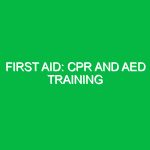In an unpredictable world, the concept of natural disaster preparedness for businesses has become not just relevant but crucial. As climate change continues to alter weather patterns, and as we witness unprecedented weather events, businesses must recognize the importance of being prepared. This guide delves into the essentials of natural disaster preparedness, its significance within the Health, Safety, and Environment (HSE) domain, and provides practical strategies to enhance readiness. Through a blend of real-life anecdotes and actionable insights, this article aims to equip business leaders with the knowledge to protect their workforce, assets, and reputation.
Understanding Natural Disaster Preparedness for Businesses
Natural disaster preparedness for businesses involves developing strategies and plans to minimize the impact of disasters such as floods, earthquakes, hurricanes, and wildfires. It is a proactive approach that not only safeguards employees but also ensures business continuity during and after a disaster. The relevance of this preparedness in the HSE domain cannot be overstated; it encompasses the safety of personnel, the protection of the environment, and the maintenance of operational integrity.
Consider the case of a small manufacturing company located in a flood-prone area. One year, a sudden storm led to devastating floods, resulting in significant damage to their facilities and equipment. However, this company had a robust disaster preparedness plan in place. Their employees were trained, evacuation routes were established, and key machinery was elevated. As a result, while many competitors struggled to recover, this company was able to resume operations within weeks. This anecdote illustrates the profound impact effective natural disaster preparedness can have on a business’s resilience.
Identifying Hazards and Risks
Understanding the potential hazards is the first step in natural disaster preparedness for businesses. Various risks can affect businesses, and these fall into the category of all-hazards preparedness. Here are some of the major types of natural disasters that businesses should consider:
Floods
Flooding can occur due to heavy rain, storm surges, or melting snow. It can damage buildings, inventory, and machinery. Businesses located near rivers or in low-lying areas are particularly vulnerable. For instance, in 2020, a heavy rainstorm led to a significant flood in a retail district, disrupting operations for weeks.
Earthquakes
Regions prone to seismic activity face the risk of earthquakes, which can cause structural damage and pose severe risks to employees. Businesses must consider retrofitting their buildings and conducting regular safety drills to ensure preparedness.
Hurricanes and Tornadoes
Coastal businesses may need to prepare for hurricanes, while those in the Midwest face threats from tornadoes. Both types of events can lead to extensive property damage and operational disruptions. For instance, a logistics company in Florida experienced significant setbacks after a hurricane knocked out power for days. Their lack of preparedness exacerbated the situation, leading to financial losses.
Wildfires
In areas susceptible to wildfires, businesses must be aware of the risks posed by dry conditions and high winds. The destruction of property and infrastructure can be swift, and a lack of preparedness can lead to severe losses.
Technological Hazards
It’s essential to understand that natural disasters can also trigger technological hazards, such as chemical spills or explosions. For example, a flood could compromise a facility storing hazardous materials, leading to environmental disasters.
Best Practices for Natural Disaster Preparedness
Once potential hazards are identified, businesses must implement best practices to ensure natural disaster preparedness. Here are several actionable strategies:
Develop a Comprehensive Emergency Plan
An effective emergency plan outlines the procedures for responding to various types of disasters. This includes evacuation routes, communication strategies, and roles for each employee during a crisis. Regularly reviewing and updating this plan is vital to adapt to any changes in the business environment or workforce.
Conduct Regular Training and Drills
Training employees on emergency procedures enhances their ability to respond effectively. Regular drills not only familiarize staff with evacuation routes but also build confidence. A notable example is a tech company that conducts quarterly drills, ensuring that employees are well-prepared for any scenario.
Invest in Infrastructure Resilience
For many businesses, investing in resilient infrastructure is crucial. This could mean retrofitting buildings to withstand earthquakes or elevating critical equipment in flood-prone areas. Take the example of a hospital that reinforced its structures and developed a backup power system. When a hurricane struck, the facility remained operational, providing critical care when it was needed most.
Establish Communication Channels
Communication is key during a disaster. Businesses should establish reliable communication channels to keep employees informed. This may include text alerts, emails, or a dedicated app. For instance, a retail chain used a mobile app to update employees during a snowstorm, ensuring everyone was aware of closures and safety protocols.
Create a Business Continuity Plan
Beyond immediate preparedness, a business continuity plan outlines how a company will continue operations post-disaster. This includes identifying critical functions, personnel, and resources required to maintain operations. For example, a financial services firm identified remote work capabilities that allowed them to continue serving clients despite extensive damage to their office building.
Regulations and Standards Governing Natural Disaster Preparedness
Natural disaster preparedness is not just a best practice; it is often mandated by regulations and standards that businesses must follow. In many jurisdictions, specific codes and standards govern construction, emergency preparedness, and employee safety. Here are a few examples:
Occupational Safety and Health Administration (OSHA) Standards
OSHA provides guidelines for emergency preparedness, requiring employers to develop emergency action plans, conduct training, and ensure employee safety during emergencies.
Federal Emergency Management Agency (FEMA) Guidelines
FEMA offers various resources and guidelines for businesses to prepare for disasters, including financial assistance programs and comprehensive planning tools.
Local and State Regulations
Many states and municipalities have their own regulations regarding disaster preparedness, often requiring businesses to submit emergency plans or participate in local preparedness programs.
The Role of Technology in Disaster Preparedness
In today’s digital age, technology plays a pivotal role in enhancing natural disaster preparedness for businesses. Advanced tools such as geographic information systems (GIS) can help businesses assess vulnerabilities and plan accordingly. For instance, a construction company used GIS data to identify flood zones, allowing them to make informed decisions about site selection and building practices.
Furthermore, cloud-based solutions enable businesses to store vital data securely, ensuring access even if physical locations are compromised. A small business that experienced a fire was able to recover quickly, thanks to its cloud-based files and systems, allowing them to continue operations with minimal disruption.
Conclusion: The Imperative of Preparedness
Natural disaster preparedness for businesses is an essential aspect of the HSE domain that can no longer be overlooked. By understanding potential hazards, implementing best practices, adhering to regulations, and leveraging technology, businesses can ensure their resilience in the face of adversity. The stories of companies that have successfully navigated disasters underscore the importance of preparation. In a world where natural disasters are increasingly common, taking proactive steps can mean the difference between recovery and catastrophic loss. As you reflect on your own business’s preparedness, consider what measures you can implement to safeguard your employees, assets, and future.


